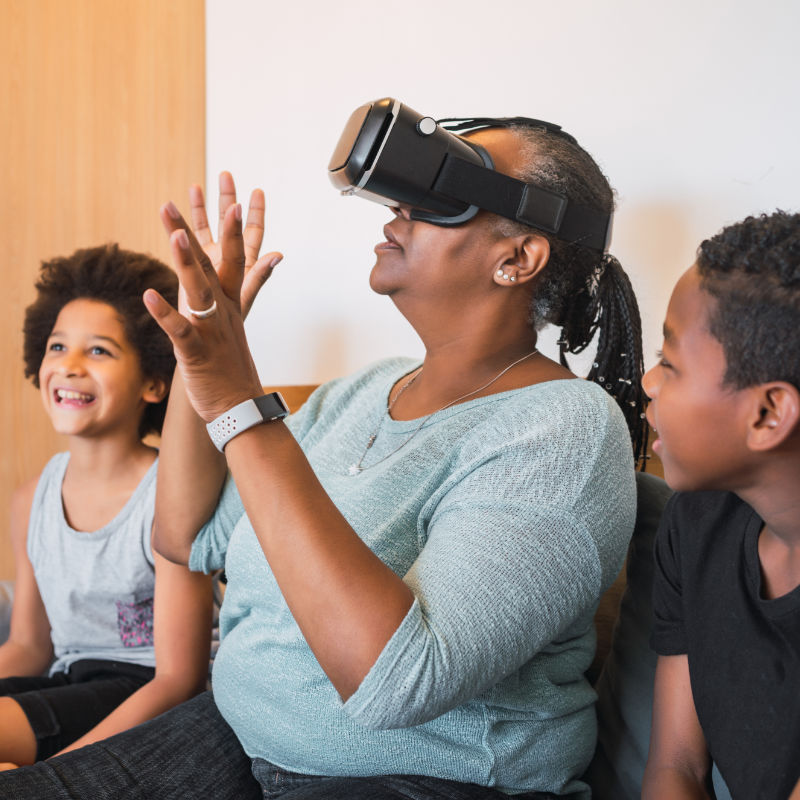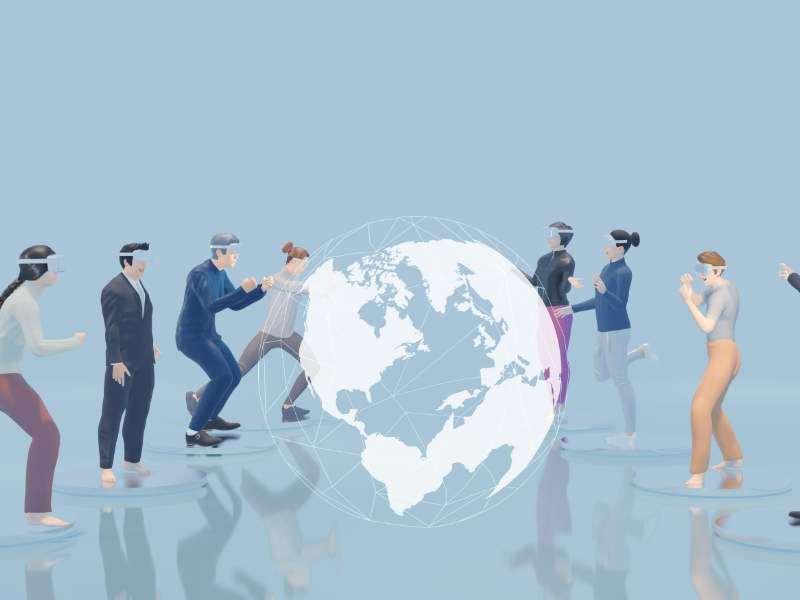Charter
The Responsible Metaverse Alliance is dedicated to supporting the development of the metaverse, or virtual worlds, so that they are handled responsibly from a perspective of design, deployment, safety, culture, inclusion, operations and function.
The RMA will focus on the ethical, transparent and acceptable uses of metaverse platforms and related technologies in a manner consistent with, 1) participant/user expectations, 2) participant/user well-being and safety, 3) organisational values, 4) diversity and inclusion and 5) societal laws and norms.

The Charter for the RMA has four key pillars:

1. Responsible Metaverse Practices
Develop best practices for designers, artists, creators and suppliers to the metaverse. This guidance goes to the social norms and behaviours that impact the culture of the metaverse and does not involve government regulation.

2. Metaverse Platform Regulation
Advise on/develop protocols, guidelines, standards, regulations and laws for the metaverse platforms.

3. Bridging of worlds
Recommend key factors to consider in bridging relationships between, 1) the virtual worlds, 2) the digital world, and 3) the physical world so that they all work together in the best interests of humanity.
The RMA will support continued efforts to ensure interoperability between the virtual worlds themselves.

4. Ensure inclusiveness in the metaverse
Develop guidelines to ensure that the design of the metaverse is done with diversity and inclusion at its core.
Support key industry players to ensure that the metaverse is widely accessible, especially to underserved communities. This must be balanced with community wishes and recognised risks.
Our views on the metaverse
What is the metaverse?
The metaverse is made up of multiple virtual worlds.
The origin of the term ‘metaverse’ comes from a book titled Snow Crash, written by Neal Stephenson. The word meta is Greek and means “among, with, after,” however in current times, meta describes a subject in a way that transcends its original limits.
The metaverse is not yet succinctly defined, however it can be described in the following way.
The metaverse is a set of immersive technologies that enable social connection in three-dimensional (3D) virtual universes that resemble reality. It relies on a network of 3D virtual worlds that utilise technologies such as virtual reality (VR), augmented reality (AR), mixed reality (MR) and haptics as well as AI, machine learning, video-conferencing, games, blockchain, cryptocurrencies, cloud, email, social media and live-streaming.

Who owns the metaverse?
The metaverse is made up of multiple virtual worlds.
The Big Tech companies regard the metaverse as the next significant technology platform evolution and are investing heavily into the technology required to build it – e.g., Meta is currently hiring 10,000 workers in Europe to build out the metaverse over the next five years (Reuters, 2021).
At this stage, the owners of the metaverse platforms are mostly private entities subject to a profit maximisation imperative.
This profit motive plus the control exercised by the owners of the metaverse platforms suggests that most if not all experiences in the metaverse will be heavily curated.
There are various owners of different virtual worlds. A number of the main providers, or suppliers to the metaverse, include:
- Epic Games/Fortnite
- Meta
- Niantic
- Nvidia
- Microsoft
- Decentraland5
- Sandbox
- Roblox
Examples of existing virtual worlds include:
- Horizon Worlds – is Meta’s virtual world
- Roblox – is a metaverse platform where users can play games made by other users
- Decentraland5 – allows users to create virtual buildings such as homes and concert halls and charge other players to visit them
- The Sandbox – is a virtual metaverse where players can build, own, and monetise their gaming experiences
- Stageverse – is a new social VR platform featuring virtual venues, digital content and interactive experiences
- Spatial – is a platform that turns any room into a 3D workspace
According to Statista, the global metaverse market was worth US$38.85 billion in 2021 and will rise to US$47.48 billion in 2022 and is estimated to be worth US$678.8 billion by 2030. (https://www.statista.com/statistics/1295784/metaverse-market-size/)
Potential metaverse harms
Commentators often lean on Snow Crash and Ready Player One as references and templates for the metaverse. Both have dystopian visions of a virtual world which is dominated by enforced scarcity of resources, highly addictive engagement driven advertising and new and potentially difficult to understand financial models. Virtual worlds in the metaverse are typically worlds run by large corporations and with no governments.
The tech companies appear to reinforce this vision of the metaverse because it aligns with their interests. And it shapes the debate to the extent that this dystopian vision of what the metaverse will look like is almost taken as a given. There is not nearly enough discussion about what kinds of virtual worlds are possible – that may not have the same dystopian characteristics.

The metaverse enables significantly higher levels of control of human experience than previous interfaces, such as social media. The metaverse environment has more levers to condition human experience and influence human behaviour than provided by the tech companies previously.
Experience with social media platforms using interfaces with significantly less powerful levers than those in a metaverse have been sufficient to alter human behaviour to create significant harm, from damaging youth mental health to undermining the public discourse. Despite the continued attempts of these organisations at making “adjustments” to their systems to ameliorate their unintended consequences, little material progress so far has been made. In October 2021, Frances Haugen brought global attention to the harms that Tech Giant Facebook (now Meta) perpetrated. Haugen noted about Meta CEO Mark Zuckerberg, “He has all the control. He has no oversight, and he has not demonstrated that he is willing to govern that company at the level that is necessary for public safety.” (Milmo, 2021a).
The platform providers appear to have built their virtual worlds as boundless marketplaces where transactions can be conducted using cryptocurrency or NFTs. Participants can earn money in metaverse by farming coins, hunting virtual creatures, attending virtual dating events, transport services, running events or a cooking school and trading NFTs. There is however already a concern being expressed by NFT Traders who have noted ‘Wash Trading’ is at play in the metaverse – where a seller takes both sides of a trade to boost an NFT’s value.
Hence, there are significant concerns that the metaverse will cause harms and unintended consequences, beyond that experienced in existing social media and gaming platforms.
Organisations aiming to deploy platforms enabling metaverse experiences should have the onus of proving otherwise: i.e., that the increased levels of control they will have will not translate into increased levels of risk for users of the platform.
If we are to predict some of the upcoming metaverse risks, we should look to what we know about other closely related technologies, namely social media and online gaming. A number of considerations come to mind when analysing risks in the metaverse:
- Data sharing and algorithmic hyper-engagement – compared to other platforms the metaverse will have more data collecting modalities, including biometric data and visual data, which will enable measurement of user attention more closely than ever before. Any AI based recommendations or advertising based on this attention data may also literally be “in your virtual face” and therefore demand more engagement than current-generation social media;
- Toxic behaviours – are already observed in most social media and online gaming communities. Most players play to have fun, but some bad actors may subvert the rules to irritate or provoke others for their own gain or amusement (called ‘griefing’) or use in-game communication to convey sexist or racist sentiment, harass players, or generally troll to provoke an outcry. Rather than joining the community with malicious intent participants might fall into these negative behaviours intermittently or after seeing that this behaviour is tolerated;
- Anonymity – a key question related to the metaverse is – to what extent are users’ identities going to be tied to their avatars, versus avatars being a disposable mask of anonymity? Currently, the metaverse platform providers do not need to make public the identities of people who have shown inappropriate or violent behaviour in their platforms;
- Learning grounds – the early accounts of aggressive and inappropriate behaviours in metaverse worlds could/should have been anticipated. Pre-emptive rather than reactive thought is required as to how new interfaces and interaction freedoms might be mis-used, and appropriate mitigations put in place. These platforms should not be the ‘learning grounds’ for tech platforms to figure out what harms can be done. After a recent assault on a woman in Meta’s virtual world, Horizon World, a Meta spokesperson, Joe Osborne, noted that the company will make “improvements” to ensure the safety of all. He stated, “…We will continue to make improvements as we learn more about how people interact in these spaces, especially when it comes to helping people report things easily and reliably.” (Frischberg, 2022). This is simply not good enough – these platforms cannot be ethical learning grounds for tech giants;
- Property risks – taking virtual property with you between metaverse worlds will necessarily depend on support from developers. If a user builds a house in a Sandbox game, can they use it as a Horizon Workrooms venue? We might naively assume that this will be possible if we draw on the analogy of physical world property. But this use case requires developers to voluntarily implement code that understands the data a user wants to bring in and this is not the case as yet. Developers related to Meta’s core offerings may have access to code and other developers from their other applications or meta-worlds who can build such representations, hence these people may be at an advantage and become more powerful avatars in this regard;
- Environmental risks – there are environmental concerns related to the metaverse. Much of the proposed infrastructure of the metaverse seems to rely on NFTs (Non-fungible Tokens) and other blockchain technologies for persistence across worlds and user verification. However, at the current time, these technologies appear to be unsustainable from an environmental perspective given that a single Ethereum transaction has a large carbon footprint of 33.4kg CO2 (Mohammed, 2022).
Illustrative incidents in the metaverse
To help illustrate some of the risks in the metaverse, two examples are provided below. One relates to a virtual sexual assault and one to a virtual real estate financial challenge.
Virtual ‘Gang Rape’ in Meta’s Horizon Worlds
In February 2022, a British woman, Nina Jane Patel, 43, who was a beta tester for Meta’s Horizon Venues, claimed she was virtually and sexually abused. Patel noted, “Within 60 seconds of joining — I was verbally and sexually harassed — 3-4 male avatars, with male voices, essentially, but virtually gang raped my avatar and took photos — as I tried to get away they yelled — ‘don’t pretend you didn’t love it’ and ‘go rub yourself off to the photo,’” (Frischberg, 2022).
Patel, recalled this experience recounting the “nightmare” she experienced, saying it was, “[a] horrible experience that happened so fast and before I could even think about putting the safety barrier in place.” (Frischberg, 2022). Patel commented: “Virtual reality has essentially been designed so the mind and body can’t differentiate virtual/digital experiences from real,” she wrote on Medium. “In some capacity, my physiological and psychological response was as though it happened in reality.” (Frischberg, 2022).
Joe Osborne, a Meta spokesperson, told The New York Post that the company will make “improvements” to ensure the safety of all. He noted, “We’re sorry to hear this happened. We want everyone in Horizon Venues to have a positive experience, easily find the safety tools that can help in a situation like this — and help us investigate and take action,” Osborne said. “Horizon Venues should be safe, and we are committed to building it that way. We will continue to make improvements as we learn more about how people interact in these spaces, especially when it comes to helping people report things easily and reliably.” (Frischberg, 2022).
Meta stated that it gives users access to tools to keep themselves safe – effectively shifting the onus of safety on to them. This is unfair and clearly does not work. As a result of this incident Meta created the Personal Boundary functionality that will prevent other avatars from invading another avatar’s personal space. (https://economictimes.indiatimes.com/magazines/panache/meta-adds-personal-boundary-tool-in-metaverse-after-virtual-world-harassment/articleshow/89359754.cms)
Squatters in Virtual Property- Upland
On 1 February 2022, Janko Roettgers, published an article on Protocol noting, “It’s the stuff of nightmares: The other day, I found my property occupied by a stranger, who was renting it out, Airbnb style.” (Roettgers, 2022). Roettgers is referring to the fact that someone had acquired the property that he owned in Upland (launched in early 2020). He went on to state, “The person who bought my property currently makes the equivalent of 4 cents a month in Upland’s in-game currency by renting it out to other players.”
Roettgers raises the following questions:
- Who should have the rights to an augmented reality (AR) layer tied to a physical address?
- What does it mean that these AR properties are being divided up among early adopters before most people even know they exist
- Will we see the same issues that have plagued real world real estate, including gentrification and displacement, replicated in AR?
- And, on a more personal level: What should I do about my virtual squatter?
In response to Roettgers’ issue, Stanford Law School professor Mark Lemley, stated, “I share the instinct of your reaction: It seems like there’s something wrong with this”. He went on to say, “I don’t know that there is an answer – this is not something the law has dealt with before, and it’s even hard to find a particularly close analogy.” (Roettgers, 2022).
References
Frank, R., (2022). Metaverse real estate sales top $500 million, and are projected to double this year. CNBC, 1 February, https://www.cnbc.com/2022/02/01/metaverse-real-estate-sales-top-500-million-metametric-solutions-says.html
Frischberg, H., (2022). Mother opens up about being ‘virtually gang raped’ in metaverse. New York Post, 1 February. https://nypost.com/2022/02/01/mom-opens-up-about-being-virtually-gang-raped-in-metaverse/
Hansen, L., (2009). What happened to Second Life? BBC News Magazine, 20 November, http://news.bbc.co.uk/1/hi/8367957.stm
Knott, M., (2021). ‘Harms children’: Whistleblower testifies that Facebook puts ‘astronomical profits’ over people. The Sydney Morning Herald. October 6, https://www.smh.com.au/world/north-america/whistleblower-says-facebook-puts-astronomical-profits-over-people-20211006-p58xjc.html
Meta (2021). Connect 2021: Our vision for the metaverse. Tech@Facebook, 28 October, https://tech.fb.com/connect-2021-our-vision-for-the-metaverse/
Milmo, D., (2021a). Facebook boss ‘not willing to protect public from harm’. The Guardian, 24 October, https://www.theguardian.com/technology/2021/oct/24/facebook-boss-not-willing-to-protect-public-from-harm
Milmo, D., (2021b). Enter the metaverse: the digital future Mark Zuckerberg is steering us toward. The Guardian, 28 October, https://www.theguardian.com/technology/2021/oct/28/facebook-mark-zuckerberg-meta-metaverse
Mohammed, S., (2022). Can NFTs Be Environmentally Friendly? Data Driven Investor. January 17, https://medium.datadriveninvestor.com/can-nfts-be-environmentally-friendly-3498b31a6b75
New World Notes (2021). Decentraland Stats: 300K Monthly Active Users, Under 20K Daily Users. 7 December, https://nwn.blogs.com/nwn/2021/12/decentraland-blockchain-metaverse-user-revenue-stats.html
Radoff, J., (2021a). What We Talk About When We Talk About the Metaverse. Building the Metaverse, 26 February, https://medium.com/building-the-metaverse/what-we-talk-about-when-we-talk-about-the-metaverse-c9ef03c1a5dd
Radoff, J., (2021b). The Metaverse Value-Chain. Medium, 7 April, https://medium.com/building-the-metaverse/the-metaverse-value-chain-afcf9e09e3a7
Reuters (2021). 10,000 in EU to build ‘metaverse’. Reuters, October 18, https://www.reuters.com/technology/facebook-plans-hire-10000-eu-build-metaverse-2021-10-17/
Roettgers, J., (2022). Who owns your address in AR? Probably not you. Protocol, 1 February, https://www.protocol.com/entertainment/upland-augmented-reality-real-estate
